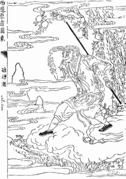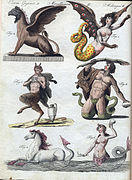
Myth is a genre of folklore consisting primarily of narratives that play a fundamental role in a society. For scholars, this is very different from the vernacular usage of the term "myth" that refers to a belief that is not true. Instead, the veracity of a myth is not a defining criterion.
Myths are often endorsed by secular and religious authorities and are closely linked to religion or spirituality. Many societies group their myths, legends, and history together, considering myths and legends to be factual accounts of their remote past. In particular, creation myths take place in a primordial age when the world had not achieved its later form. Origin myths explain how a society's customs, institutions, and taboos were established and sanctified. National myths are narratives about a nation's past that symbolize the nation's values. There is a complex relationship between recital of myths and the enactment of rituals. (Full article...)

lithograph by R. de Moraine
Les Tribunaux secrets (1864)
Legends of vampires have existed for millennia; cultures such as the Mesopotamians, Hebrews, ancient Greeks, and Romans had tales of demonic entities and blood-drinking spirits which are considered precursors to modern vampires. Despite the occurrence of vampire-like creatures in these ancient civilizations, the folklore for the entity known today as the vampire originates almost exclusively from early 18th-century Central Europe, particularly Transylvania as verbal traditions of many ethnic groups of the region were recorded and published. In most cases, vampires are revenants of evil beings, suicide victims, or witches, but can also be created by a malevolent spirit possessing a corpse or a living person being bitten by a vampire themselves. Belief in such legends became so rife that in some areas it caused mass hysteria and even public executions of people believed to be vampires. (Full article...)
- ...that the Tigmamanukan, a Philippine mythological bird, can be a good or bad omen depending on the direction of its flight?
- ... that, in the lives of saints, the appearance of roses (example pictured) sometimes announces the presence or activity of God?
- ... that the pre-Columbian Zapotec storm god Cocijo was said to have created the world from his breath?
- ... that the worshippers of Xipe Totec (pictured), the Aztec god of renewal, wore the flayed skins of their sacrificial victims?
Featured Articles:
![]() Ahalya,
Ahalya, ![]() Ancient Egyptian literature,
Ancient Egyptian literature, ![]() King Arthur,
King Arthur, ![]() Ganesha,
Ganesha, ![]() Iravan,
Iravan, ![]() Orion (mythology),
Orion (mythology), ![]() Vampire,
Vampire, ![]() Vithoba
Vithoba
Featured Lists:
![]() List of valkyrie names in Norse mythology
List of valkyrie names in Norse mythology
Good Articles:
![]() 2012 phenomenon,
2012 phenomenon,
![]() Æsir–Vanir War,
Æsir–Vanir War,
![]() Ala (demon),
Ala (demon),
![]() Anu,
Anu,
![]() Aphrodite,
Aphrodite,
![]() Athena,
Athena,
![]() Ardhanarishvara,
Ardhanarishvara,
![]() Battle of Barry,
Battle of Barry,
![]() Bhikshatana,
Bhikshatana,
![]() Catalogue of Women,
Catalogue of Women,
![]() Chamunda,
Chamunda,
![]() Chhinnamasta,
Chhinnamasta,
![]() Consorts of Ganesha,
Consorts of Ganesha,
![]() Cú Chulainn,
Cú Chulainn,
![]() Dhumavati,
Dhumavati,
![]() Dumuzid,
Dumuzid,
![]() Einherjar,
Einherjar,
![]() Eir,
Eir,
![]() Enlil,
Enlil,
![]() Fairy Flag,
Fairy Flag,
![]() Fenrir,
Fenrir,
![]() Gerðr,
Gerðr,
![]() Hel (being),
Hel (being),
![]() Huginn and Muninn,
Huginn and Muninn,
![]() Iðunn,
Iðunn,
![]() Ila (Hinduism),
Ila (Hinduism),
![]() Inanna,
Inanna,
![]() Kabandha,
Kabandha,
![]() Kali,
Kali,
![]() Kamadhenu,
Kamadhenu,
![]() Kangiten,
Kangiten,
![]() Keshi (demon),
Keshi (demon),
![]() Khandoba,
Khandoba,
![]() Kratos (mythology)
Kratos (mythology)
![]() Krishna,
Krishna,
![]() Kubera,
Kubera,
![]() LGBT themes in Hindu mythology,
LGBT themes in Hindu mythology,
![]() Manasa,
Manasa,
![]() Mandodari,
Mandodari,
![]() Matangi,
Matangi,
![]() Matrikas,
Matrikas,
![]() Maya Sita,
Maya Sita,
![]() Mohini,
Mohini,
![]() Myrrha,
Myrrha,
![]() Mythology of Carnivàle,
Mythology of Carnivàle,
![]() Naraka (Hinduism),
Naraka (Hinduism),
![]() Ninurta,
Ninurta,
![]() Prester John,
Prester John,
![]() Prithu,
Prithu,
![]() Putana,
Putana,
![]() Rati,
Rati,
![]() Ratatoskr,
Ratatoskr,
![]() Revanta,
Revanta,
![]() Satyavati,
Satyavati,
![]() Satyr,
Satyr,
![]() Sharabha,
Sharabha,
![]() Shashthi,
Shashthi,
![]() Shiva,
Shiva,
![]() Sif,
Sif,
![]() Tara (Ramayana),
Tara (Ramayana),
![]() Troilus,
Troilus,
![]() Tuisto,
Tuisto,
![]() Valhalla,
Valhalla,
![]() Valkyrie,
Valkyrie,
![]() Vampire folklore by region,
Vampire folklore by region,
![]() Varaha,
Varaha,
![]() Varahi,
Varahi,
![]() Veðrfölnir and eagle
Veðrfölnir and eagle
![]() Zduhać
Zduhać

Sharabha (Sanskrit: शरभ, Śarabha) or Sarabha is an eight-legged part-lion and part-bird deity in Hindu religion, who is described as more powerful than a lion or an elephant, possessing the ability to clear a valley in one jump in Sanskrit literature. In later literature, Sharabha is described as an eight-legged deer.
The Shaiva scriptures narrate that the deity Shiva assumed the form of Sharabha to pacify Narasimha - the fierce man-lion avatar of Vishnu worshipped by the Vaishnava sect. This form is popularly known as Sharabheshvara ("Lord Sharabha") or Sharabheshvaramurti. Vaishnavas refute the portrayal of Narasimha as being destroyed by Shiva-Sharabha, and regard Sharabha as a name of Vishnu. Some Vaishnava scriptures such as the Narasimha Purana suggest that Vishnu assumed the form of the ferocious two-headed bird Gandabherunda, who in turn defeated Sharabha. (Full article...)
- Help with the myth and folklore missing articles project.
- Help create requested articles.
- Help assessment at Wikipedia:WikiProject Mythology/Assessment.
- Place the project banner {{WikiProject Mythology}} on the talk pages of all relevant articles.
- Check the recent changes for recent improvements, vandalism, and other changes.
- Answer requests for mythology articles needing attention: Category:Mythology articles needing attention
- Answer requests for mythology articles needing expert attention: Category:Mythology articles needing expert attention
- Expand articles tagged as mythology stubs: Category:Mythology stubs
- Assist mythology subprojects.
- Add requested photographs of mythology subjects: Category:Wikipedia requested photographs of mythology subjects
The following Wikimedia Foundation sister projects provide more on this subject:
-
Commons
Free media repository -
Wikibooks
Free textbooks and manuals -
Wikidata
Free knowledge base -
Wikinews
Free-content news -
Wikiquote
Collection of quotations -
Wikisource
Free-content library -
Wikiversity
Free learning tools -
Wiktionary
Dictionary and thesaurus













































































































